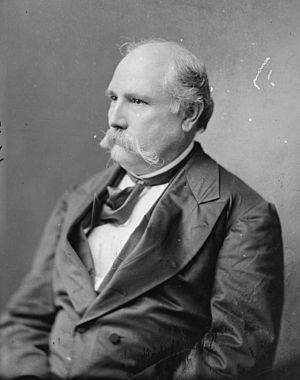James Lusk Alcorn
James Lusk Alcorn (November 4, 1816 – December 19, 1894) was a prominent American political figure in Mississippi during the 19th century. He was the leading Scalawag during Reconstruction in Mississippi, where he served as governor. He briefly served as a Confederate general during the early part of the American Civil War.
Early life and career
Born near Golconda, Illinois, of a Scotch-Irish family, he attended Cumberland College in Kentucky and served as deputy sheriff of Livingston County, Kentucky, from 1839-1844. As his law practice flourished and his property holdings throughout the Mississippi Delta increased, he became a wealthy man. By 1860, he owned nearly a hundred slaves and held lands valued at a quarter of a million dollars. He was a leader of the Whig Party. He served in the state House of Representatives and Senate during the 1840s and 1850s. He was defeated for Congress in 1857.
Alcorn was a delegate to the Mississippi convention of 1851, called by Governor Quitman to build momentum for secession. Alcorn helped defeat that movement. Like many Whig planters, Alcorn initially opposed secession, pleading with the extremists to reflect for a moment on the realities of regional power. He foretold a horrific picture of a beaten South, "when the northern soldier would tread her cotton fields, when the slave should be made free and the proud Southerner stricken to the dust in his presence."[1]
Civil War
When secession passed, Alcorn cast his lot with the Confederacy and was selected as a brigadier general by the state. During the American Civil War, he was in uniform for about 18 months in inconspicuous service. Both his sons, James Alcorn Jr. and Henry Alcorn, died during the war—James Jr. in battle and Henry of typhoid fever. He managed to maintain his wealth during the Civil War by selling cotton to U.S. Treasury agents. After the war, he was estimated to be among the fifty wealthiest men in the South.
Postbellum career
He was elected to the U.S. Senate in 1865, but, like all Southerners, was not allowed to take a seat as Congress was pondering Reconstruction. He supported suffrage for Freedmen and endorsed the Fourteenth Amendment. Alcorn became the leader of the Scalawags, who comprised about a third of the Republican party in the state, in coalition with carpetbaggers and Freedmen. He was elected by the Republicans as governor in 1869, serving, as Governor of Mississippi from 1870 to 1871. As a modernizer, he appointed many like-minded former Whigs, even if they were now Democrats. He strongly supported education, including public schools for blacks only, and a new college for them, now known as Alcorn State University. He maneuvered to make his ally, Hiram Revels, its president. Radical Republicans opposed Alcorn, angry at his patronage policy. One complained that Alcorn's policy was to see "the old civilization of the South modernized" rather than lead a total political, social and economic revolution.[2]
Alcorn resigned the governorship to become a U.S. Senator (1871–1877), replacing his ally Hiram Revels, the first African American senator. Senator Alcorn urged the removal of the political disabilities of whites southerners and rejected Radical Republican proposals to enforce social equality by federal legislation[3]; he denounced the federal cotton tax as robbery[4] and defended separate schools for both races in Mississippi. Although a former slaveholder, he characterized slavery as "a cancer upon the body of the Nation" and expressed the gratification which he and many other Southerners felt over its destruction [5].
Alcorn led a furious political battle with Senator Adelbert Ames, the carpetbagger who led the Radical faction of the Republican party in Mississippi, based on black votes. The fight ripped apart the Republican party. In 1873, they both sought a decision by running for governor. Ames was supported by the Radicals and most African Americans, while Alcorn won the votes of conservative whites and most of the scalawags. Ames won by a vote of 69,870 to 50,490.
During the Reconstruction era, Alcorn was an advocate of modernizing the South. Although a believer in white supremacy, he supported civil and political rights for African-Americans. In a letter to his wife Amelia he states that Southerners must make the Negro their friend or "the path ahead will be red with blood and damp with tears." Alcorn was the founder of the Mississippi levee system, and was instrumental in their rebuilding after the Civil War.
After his retirement from politics, he was active in levee affairs and was a delegate to the Mississippi constitutional convention of 1890, in which he supported the black disfranchising clause of the new constitution. He was twice married: in 1839 to Mary C. Stewart of Lexington County, Ky., who died in 1849; and in 1850 to Amelia Walton Glover of Alabama. Alcorn lived quietly at his plantation, Eagle's Nest, in Coahoma County, Mississippi, until his death and interment on the estate grounds in 1894.
Alcorn County, Mississippi is named in his honor, as is Alcorn State University, originally set up for African Americans.
Bibliography
- William C. Harris; The Day of the Carpetbagger: Republican Reconstruction in Mississippi Louisiana State University Press, 1979
- William C. Harris; Presidential Reconstruction in Mississippi Louisiana State University Press, 1967
- Pereyra, Lillian A. James Lusk Alcorn: Persistent Whig LSU Press, 1966.
- Riley, Franklin Lafayette, "Alcorn, James Lusk" in Dictionary of American BiographyVolume 1 (1928).
